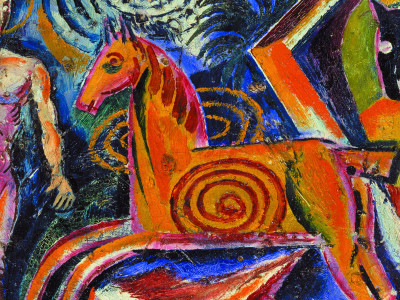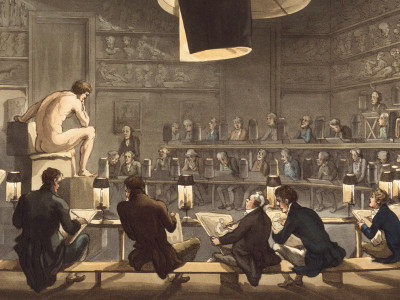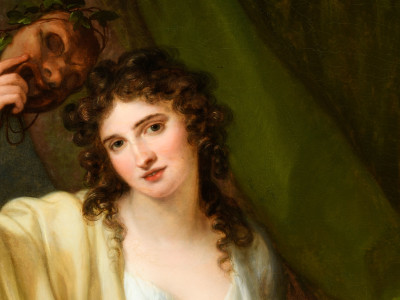
The meteoric rise of Angelica Kauffman RA
By Jenny Uglow
Published on 2 January 2024
Historian Jenny Uglow tells the story of how Angelica Kauffman became a founding Member of the RA and one of the most revered artists in Georgian Britain.
An earlier version of this article was published in the Summer 2020 issue of RA Magazine.
In October 1766, four months after Angelica Kauffman arrived in London from Rome, aged 25, she wrote exuberantly to her father:
"I have finished some portraits which are snapped up by everyone, Mr Reynolds is excessively pleased with them… This morning I had a visit from Mrs Garrick. Milady Spencer was here two days ago. Lord Baltimore also visits me occasionally. The Queen was delivered of a child two days ago, as soon as she is better I shall be presented to her…"
She was the darling of society. Two years later she was one of the two women, with the young flower painter Mary Moser, to be founder Members of the Royal Academy of Arts. Engravings of her paintings spread her fame across the country, while scenes "after Kauffman" decorated bookcases and side tables, snuff boxes and fans. In 1781 the Danish ambassador quoted an engraver as saying "The whole world is Angelicamad."
The Georgians loved Kauffman’s lightness of touch and expressive feeling. Her work forms a bridge between the cult of sensibility and sterner neo-classicism, and she is fascinating too for the way she negotiated, and even exploited, her position as a woman artist. There were other famous female portraitists in the 18th century, including Rosalba Carriera and Elisabeth Vigée-LeBrun, but they were a tiny minority, with many obstacles to overcome. Women were barred from drawing from the nude in the Life Room (in Johann Zoffany’s painting The Academicians of the Royal Academy (1771-72), set in the Life Room at the RA, Kauffman and Moser are represented only as portraits on the wall). Beyond that, many felt, in Samuel Johnson’s words, that "public practice of any art, and staring in men’s faces, is very indelicate in a female."

Although rumours of dalliance followed Kauffman from Italy – the painter Nathaniel Dance was one of many who fell in love with her – she was careful not to appear "indelicate". To her wealthy clientele she seemed brilliantly unthreatening: pretty but not beautiful, modest and easy to talk to and (genuinely) kind. She was also canny. Although she came to London in June 1766 as the protegée of Lady Wentworth, wife of the British ambassador to Venice, she had already engineered an even more effective introduction in advance, sending her portrait of the actor David Garrick, painted in Naples, to the exhibition of the Free Society of Artists the previous year. Garrick’s face was already famous, but unlike other artists, Kauffman painted him not as an actor in a role, but in a plain brown overcoat, gazing quizzically over the back of a chair (Portrait of the Actor David Garrick, 1764). She borrowed the pose from the convivial portraits of Frans Hals, but used it cleverly, so that it seems both a barrier to flirtation and a defence for the sitter against her penetrating gaze – Garrick’s face is relaxed but his hands grip the edge of the chair. The effect is warm, amusing, alive. As if to acknowledge who had the upper hand, Garrick sent a verse to the St James’s Chronicle:
While thus you paint with Ease and Grace,
And Spirit all your own;
Take, if you please, my Mind and Face,
But let my Heart alone.
It was a time of new interest in the "self", in the gap between the roles people play and their inner lives, between face and heart. Alert to this, Kauffman explored her own life choice in self-portraits. She was born in Switzerland in 1741, the daughter of a Swiss mother, Cleofea, and an Austrian artist, Johann Joseph Kauffman. At 12, she painted Self Portrait with a Sheet of Music (1753), with round face and brown eyes, blue dress and pink ribbon, looking serious and determined. Would she concentrate on the ‘feminine’ art of music – her voice was sweet, and her talent evident – or follow her artist father? She chose the latter, and following her mother’s death when she was 13, her father trained her. After working in his native Bregenz Forest in Austria (in several self-portraits Angelica wears the dress of this alpine region, suggesting a – fabricated – rural innocence), they travelled round Italy, where she copied Old Masters in the galleries and produced work that won her acceptance in the prestigious academies of Bologna, Florence and Rome.
Looking back in later life, she staged that early choice again in Self-Portrait of the Artist Hesitating Between the Arts of Music and Painting (1794). Adapting the classical format of the Choice of Hercules, between the paths of Vice and Virtue, she casts a tender look towards Music but gestures towards the palette offered by Art, who looks far more dynamic in her blue dress and swirling red sash, gesturing to the mountains, to sublimity and the temple on the heights. But Kauffman’s painting, she implies, as she holds Music’s hand, will not be a rivalrous but a sisterly art. In her self-portraits she often took a pose commonly used by amateur women painters, holding her paintbrush or sketchbook, gazing calmly at the viewer. Women were among her chief patrons, and sisterhood was important to her. In one of her grandest, most Gainsborough-like canvases, Portrait of the Siblings Spencer (c.1774), she portrays two real sisters, Henrietta and Georgiana (about to become Duchess of Devonshire), sitting together with clasped hands, while their brother Viscount Althorp stands pensively to one side – in engravings he was often cut out altogether.

Self-portrait with a sheet of music, 1753

Self-portrait with the Bust of Minerva, c. 1780

Maria from Sterne, 1772

Portraits made Kauffman rich, yet she was ambitious to reach even higher. In 1766, Joshua Reynolds, who two years later would become President of the new Royal Academy, quickly became her friend (satirists implied more) and her portrait of him (1767), seated beneath a Michelangelo bust by a table heaped with the books of his friends, Johnson, Goldsmith and Burke, glows with affection. His patronage, and that of Queen Charlotte, undoubtedly helped her election to the Royal Academy. But she won her place for her painting, especially her bold decision – very rare for a woman – to tackle history and mythological painting, then seen as the highest genre.
Yet in this realm, where men were the heroes and women excluded from action, Kauffman still managed to assert women’s power. When she depicts the story of Odysseus (also known as Ulysses), she does so in female – or feminised – portrayals: his discovery of Achilles disguised as a girl, which was his mother Thetis’s ruse to save him from the Trojan War (Achilles Discovered by Ulysses amongst the Daughters of Lycomed, 1788); his wife Penelope, protected by Athena, weaving and unravelling her work; his enchantment by Circe, who keeps her dangerous wand by her side, out of sight. Other subjects included Pompey’s wife Julia, Cleopatra at Mark Antony’s tomb, and Cornelia, mother of the Gracchi. Female stories encircle male heroes. Comparing Kauffman’s paintings to those of Benjamin West in 1771, the artist Mary Delany decided, "My partiality leans to my sister painter. She certainly has a great deal of merit but I like her history still better than her portraits."
In both genres fashion was important, and Kauffman played to the prevailing tune, sentimental, classical or Oriental. She was adept at the appeal to sympathy and her painting of Poor Maria from Laurence Sterne’s novel A Sentimental Journey through France and Italy, stricken by grief, seated under a tree with her faithful dog (Maria from Sterne, 1772), became a veritable icon of the age of sensibility, and was engraved and copied across Europe. Many women sitters asked to be painted in fashionable allegorical or classical guises – as Hope, or Chastity, or Hebe. Others opted for turqueries, dressing in the style of Turkish women of the harem, a vogue inspired by Mary Wortley Montagu’s Turkish Embassy Letters, published in 1763. While this form of Orientalism seems to relegate women to being objects of desire, Kauffman’s luscious paintings, with their detailed, elaborate costumes, celebrate independence as well as allure. In the harem, Montagu had insisted, women had their own society, free from the gaze of men. "I look upon the Turkish women,’ she wrote, ‘as the only free people in the Empire".

In the late 1760s Kauffman painted her self-portrait in Turkish dress, with direct simplicity. She herself was a free spirit, despite outward constraints. Yet at the time she had her own troubles, being duped into a brief marriage in 1767 with the Count de Horn, a bigamist and fraudster. The disaster made her nervous of emotional engagement, but when she left London for Italy in 1781, having made a fortune, she married the painter Antonio Zucchi, 15 years her senior, who had worked on decorative schemes for Robert Adam. It was a loving as well as practical relationship, and in Rome her salon became a meeting place for artists, writers and musicians: Goethe was her friend, and Canova carved her monument when she died in 1807.
She made a lasting impression. In 1778, the Royal Academy commissioned a set of four ‘Elements of Art’ for the ceiling of their Council Room in Somerset House, based on Reynolds’ Discourses. Now installed on the entrance hall ceiling at Burlington House, Kauffman’s huge paintings depict four women, personifying Invention, Composition, Design and Colour. All are vital and intense, their strong limbs and clear gestures looking back to female forebears like the Baroque painter Artemisia Gentileschi. In Design, a woman wearing an artist’s working clothes draws not from life but from a cast of the Belvedere Torso, as Kauffman would have had to do as a student. These grand paintings, and her portraits and mythological works, affirm her own eminence as an artist, equal to any man of her time.
Jenny Uglow is a historian. She has written biographies of George Eliot, William Hogarth and Thomas Bewick.
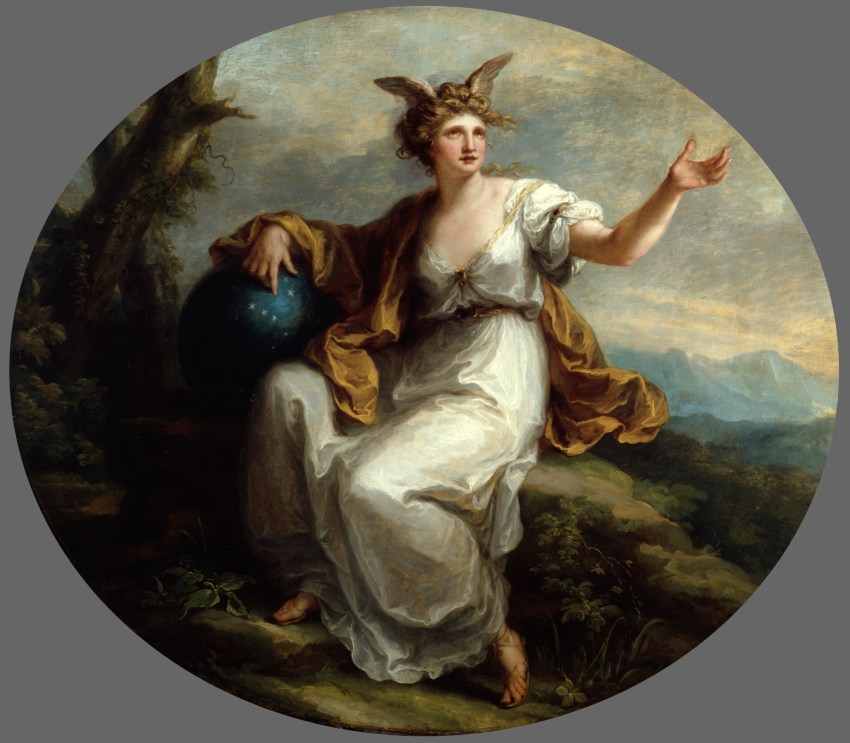
Invention, 1778-80
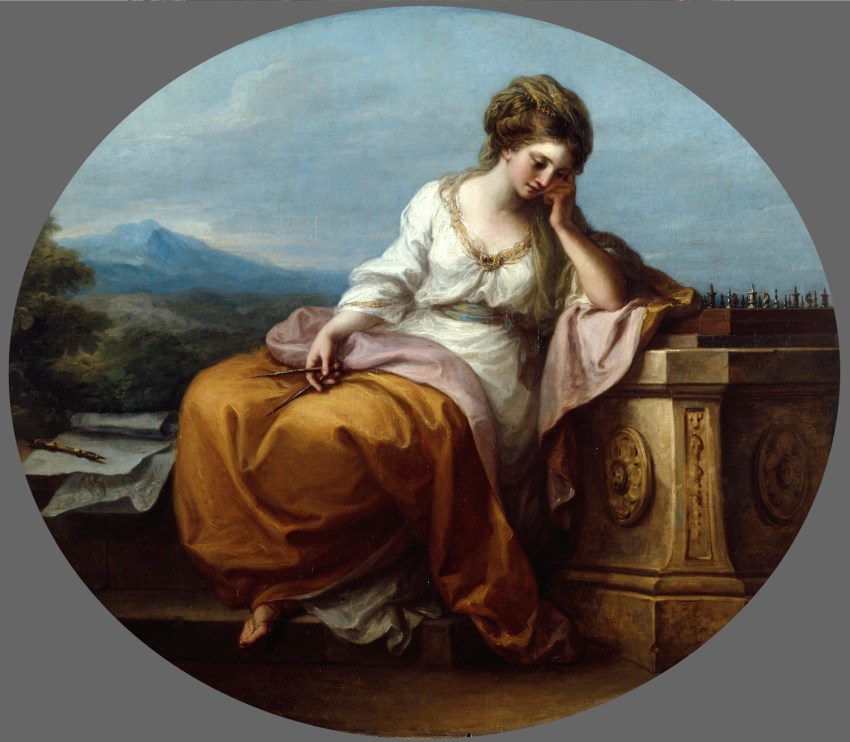
Composition, 1778-80
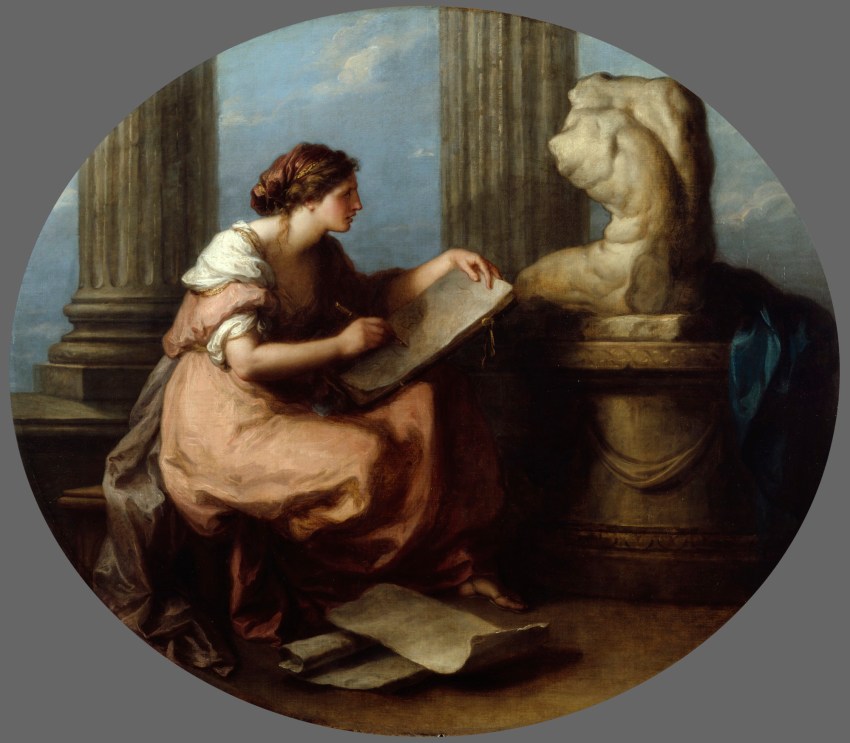
Design, 1778-80
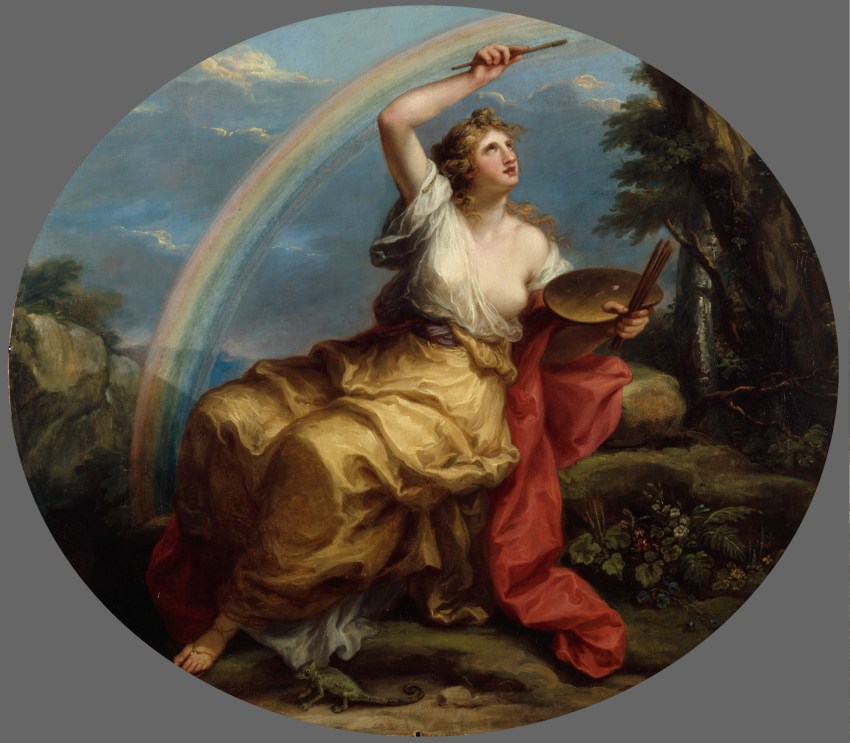
Colouring, 1778-80
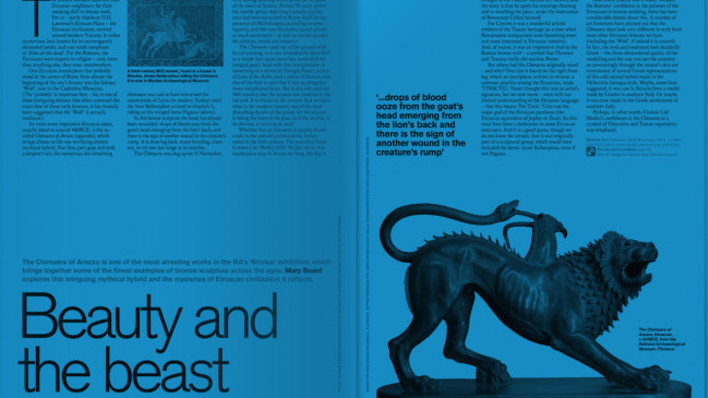
Enjoyed this article?
As well as free entry to all of our exhibitions, Friends of the RA enjoy one of Britain’s most respected art magazines, delivered directly to your door. Why not join the club?
